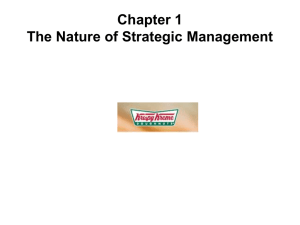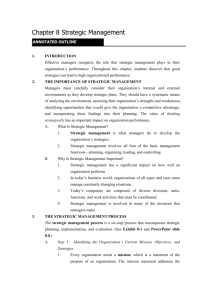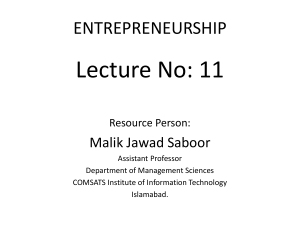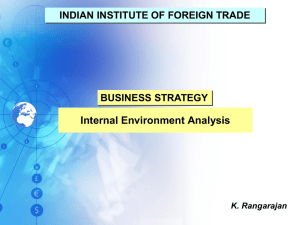Management 8e. - Robbins and Coulter
advertisement
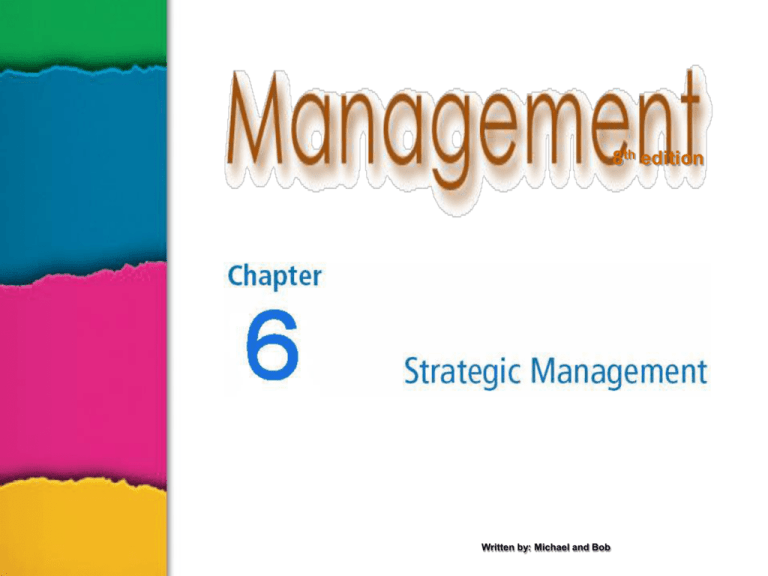
8th edition Written by: Michael and Bob Strategic Management • The set of managerial decisions and actions that determines the long-run performance of an organization. Strategy: A detailed and organized plan of action. Page 121 Slide 2 Why Strategic Management Is Important Studies have shown a positive relationship between strategic planning and the improved performance of an organization. It is the reason why firms succeed or fail. It enables managers to cope with the uncertain environments. Page 122 It causes managers to examine the changing situation in deciding how to proceed. Slide 3 Why Strategic Management Is Important It coordinates the work activities of the different organizational units. It keeps them focused on achieving the organization’s goals. It is involved in many of the decisions that managers make. Page 122 Most of the important business events reported in the news involve strategic management. Slide 4 Strategic Management Process A six-step process. 1. Identifying the organization’s current mission, objectives, and strategies. 2. External analysis. 3. Internal analysis. 4. Formulating strategies. 5. Implementing strategies. 6. Evaluating results. The first four describe the planning that takes place, the last two deal with implementation and evaluation. Page 123 Slide 5 The Strategic Management Process Exhibit 8.1 Page 123 Slide 6 Strategic Management Process • Step 1: Identifying the organization’s current mission, objectives, and strategies The Mission: What is the firm’s reason for being in business. What is the scope of its products and/or services. The Goals and Strategies: They are the foundation of planning. They provide measurable performance targets. They give managers a basis for evaluating whether goals need to be changed. Page 123 Slide 7 Components of a Mission Statement • Customers: Who are the organization’s customers? • Products or services: What are the organization’s major products or services? • Markets: Where does the organization compete geographically? • Technology: How technologically current is the organization? • Concern for survival growth, and profitability: Is the organization committed to growth and financial stability? • Philosophy: What are the organization’s basic beliefs, values, aspirations, and ethical priorities? • Self-concept: What is the organization’s major competitive advantage and core competencies? • Concern for public image: How responsive is the organization to societal and environmental concerns? • Concern for employees: Does the organization consider employees a valuable asset? Source: Based on F. David, Strategic Management, 8th ed. (Upper Saddle River, NJ: Prentice Hall, 2001), pp. 65–66. Page 124 Exhibit 8.2 Slide 8 Strategic Management Process • Step 2: Conducting an external analysis. Managers need information that might affect the organization, e.g. on the competition, government legislation, local labor supply, etc… Managers examine the changes that take place in the specific and general environments so they can develop appropriate strategies. They assess (measure) what they have learned in terms of opportunities and threats. Page 124 Slide 9 Strategic Management Process • Step 3: Conducting an internal analysis. The managers evaluate the organization’s resources and capabilities to determine its strengths and weaknesses. Resources: Such as capital, technical excellence, skilled employees, experienced managers. Capabilities: In performing activities such as manufacturing, marketing, engineering, etc.. Core competencies: Capabilities or resources that are exceptional or unique – The core competencies of the organization determine its competitive weapons. • Note: Steps 2 and 3 combined are called a SWOT analysis. (Strengths, Weaknesses, Opportunities, and Threats) Page 125 Slide 10 Identifying the Organization’s Opportunities Exhibit 8.3 Page 126 Slide 11 Strategic Management Process • Step 4: Formulating (expressing) strategies. Develop and evaluate strategic alternatives (choices). Select strategies that capitalize (take advantage of) on the organization’s strengths and exploit (use) environmental opportunities. Correct weaknesses and develop protection against threats. This step is considered successful when managers have developed strategies that suggest (show) a reasonable advantage over competitors. Page 126 Slide 12 Strategic Management Process • Step 5: Implementing strategies New strategies can only succeed if implemented properly. Implementation often require hiring new employees, transferring or laying off (firing) current ones. The ability to build and manage effective teams is an important part of implementation. Top management leadership and motivated middle and lower-level managers are necessary ingredients (elements or components) in a successful strategy. Page 126 Slide 13 Strategic Management Process • Step 6: Evaluating Results How effective have strategies been? What adjustments, if any, are necessary? An assessment of the results of previous strategies may provide ground (a reason) for making changes as needed. Page 127 Slide 14 CHAPTER REVIEW The Importance of Strategic Management (Slides 3,4) • Discuss what studies of the effectiveness of strategic management have shown. • Explain why strategic management is important. The Strategic Management Process (Slides 5,9,10) • List six steps in the strategic management process. • Describe what managers do when they do external and internal analyses. • Explain the role of resources, capabilities, and core competencies in the internal analysis. Page 119 Slide 15
